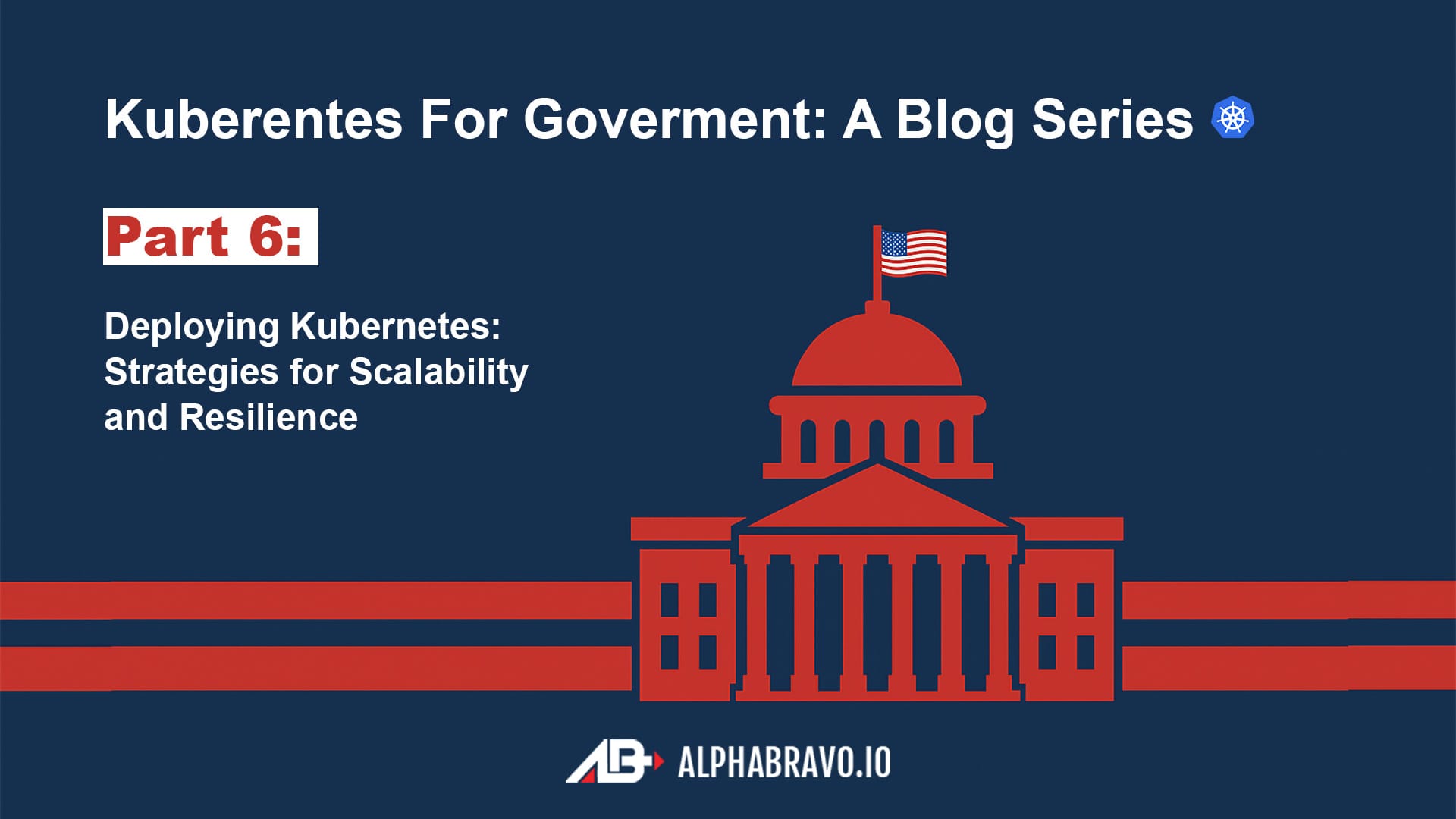Deploying Kubernetes: Strategies for Scalability and Resilience (Part 6)
Mission-Critical Kubernetes: Architecting for Scale, Surviving the Failures

As we venture deeper into our Kubernetes for Government journey, we arrive at perhaps the most architecturally significant challenge: designing deployments that can both scale with demand and withstand the inevitable failures that occur in distributed systems. If you've been following our series so far (from foundational concepts, through containerization principles, operational models, security controls, and federal IAM requirements), you've built a solid foundation. Now it's time to architect for scale and resilience – because in government IT, "good enough" rarely is.
One Cluster, Two Cluster, Red Cluster, Blue Cluster: Multi-Cluster Architectures
The day will inevitably come when a single Kubernetes cluster proves insufficient – whether due to geographical distribution requirements, the need for stronger workload isolation, or simply because you've hit scaling limits. Multi-cluster Kubernetes architectures offer elegant solutions to these challenges, but they come with their own set of complexities.
Multi-cluster Kubernetes refers to an environment consisting of two or more distinct Kubernetes clusters, each with its own control plane and worker nodes. This approach differs from federated Kubernetes (kubefed), where a single control plane manages multiple clusters. The distinction is crucial for government deployments where control boundaries often align with security domains.
There are two primary architectural patterns for multi-cluster deployments:
Replicated Architecture: The "Belt AND Suspenders" Approach
In a replicated architecture, identical applications and services are deployed across multiple clusters, creating redundancy. This approach is particularly valuable for mission-critical systems where downtime is unacceptable. When one cluster fails, applications remain available in other clusters – the digital equivalent of having backup parachutes for your backup parachutes.
This approach particularly shines in government environments where geographic distribution requirements often dictate deploying redundant systems across physically separate facilities. Just like government agencies have contingency plans for their contingency plans, your Kubernetes architecture should embrace similar levels of redundancy for truly critical workloads.
Split-by-Service Architecture: The "Stay In Your Lane" Approach
The split-by-service architecture takes a different tack, hosting different services across different clusters and using service meshes to route requests appropriately. This isolation provides enhanced security benefits and resource optimization, allowing services to be deployed to clusters optimized for their specific requirements.
For government agencies with clear functional boundaries between systems, this model often aligns nicely with organizational structures – letting the intelligence analysis cluster focus on intelligence analysis workloads while the logistics systems operate in their own dedicated environment.
When 99.9% Uptime Isn't Enough: High Availability Kubernetes
In government environments where systems support critical infrastructure, defense capabilities, or essential citizen services, high availability isn't a luxury – it's a mandate. Kubernetes offers several built-in mechanisms for high availability, but they require deliberate configuration and testing to ensure they perform as expected under stress.
The HA Control Plane: Your Cluster's Central Nervous System
The control plane serves as the brain of your Kubernetes cluster, making decisions about scheduling, scaling, and responding to changes in system state. A highly available control plane ensures uninterrupted cluster management during failures.
Building a production-worthy HA control plane typically involves:
- Distributing multiple API server instances across availability zones
- Implementing etcd clustering with proper quorum configuration
- Ensuring scheduler and controller manager redundancy
- Configuring proper leader election mechanisms
Remember that etcd, which stores all cluster state, requires special attention to ensure data consistency. Like a government committee, etcd needs a quorum to make decisions – and you can lose minority members without losing functionality.
Self-Healing Mechanisms: Kubernetes' Immune System
Kubernetes shines with its native defenses against individual pod failures. These self-healing mechanisms act as your cluster's immune system, automatically detecting and recovering from failures:
- Liveness probes detect hung applications and trigger restarts
- Readiness probes ensure only healthy pods receive traffic
- Pod disruption budgets maintain minimum availability during updates
- ReplicaSets ensure the desired number of pods are always running
These mechanisms ensure that only healthy pods serve traffic, enhancing application architecture resilience. It's like having an army of tiny system administrators constantly monitoring and fixing issues before you even know they exist – except they never complain about being on call.
Pod Scheduling for Fault Tolerance: Don't Put All Your Pods in One Basket
Strategic pod scheduling is vital for achieving HA in Kubernetes. By intelligently distributing pods across your cluster, you prevent single points of failure and enhance overall fault tolerance.
Tools like pod anti-affinity rules ensure critical workloads are spread across nodes, availability zones, or even regions. This approach mirrors traditional government resilience planning, where critical functions are distributed across multiple facilities to survive localized disruptions.
Straddling Worlds: Cross-Environment Deployment
Many government agencies find themselves in the challenging position of managing both on-premises infrastructure and cloud resources – often with strict requirements about what can run where. Modern Kubernetes deployments need to embrace this hybrid reality.
The FedRAMP Puzzle
For agencies serving the federal market, FedRAMP authorization represents a critical compliance hurdle. The use of Kubernetes in FedRAMP environments presents unique challenges due to the dynamic nature of container orchestration and the mutability of network identity.
However, Kubernetes can actually simplify some aspects of FedRAMP compliance. For example, implementing FIPS-validated encryption of data in transit can be easier to achieve with proper Kubernetes network policies and service mesh implementations. Tools like Buoyant Enterprise for Linkerd provide FIPS-compliant service mesh capabilities specifically designed for government environments.
When navigating FedRAMP requirements, it's essential to document how Kubernetes features map to specific controls. This often requires translating technical capabilities into compliance language – much like explaining to your grandmother how your smartphone works, except your grandmother is a federal auditor who can halt your entire operation.
To Infinity and Beyond: Scaling Strategies
Scalability in Kubernetes operates along three primary dimensions, each with its own tools and approaches:
Horizontal Pod Autoscaling: More Pods, More Power
Horizontal scaling involves adjusting the number of pod replicas to meet changing demands. The Horizontal Pod Autoscaler (HPA) automatically scales the number of pods based on observed metrics like CPU utilization or memory usage.
This approach is particularly effective for stateless applications that can be easily replicated. Like adding more customer service representatives during peak hours, horizontal scaling ensures your application has enough instances to handle incoming requests without overloading individual pods.
Vertical Pod Autoscaling: Supersizing Your Pods
Vertical scaling takes a different approach, adjusting the resources (CPU and memory) allocated to existing pods. While not included in Kubernetes by default, the Vertical Pod Autoscaler (VPA) project provides this functionality.
Vertical scaling is useful for workloads that cannot be easily horizontally scaled, such as databases or applications with complex state management. It's like giving your existing staff performance-enhancing supplements rather than hiring more people.
Cluster Autoscaling: Expanding Your Real Estate
When your workloads outgrow your existing infrastructure, cluster autoscaling comes to the rescue by automatically adjusting the size of your Kubernetes cluster. This involves adding or removing nodes based on resource demands, ensuring you have enough capacity without wasting resources on idle nodes.
With its distributed architecture, Kubernetes can support impressively large deployments - up to 5000 nodes and 150,000 pods in recent releases. However, managing this scale requires careful planning and monitoring to ensure performance and cost optimization.
Preparing for the Inevitable: Kubernetes vs. Murphy's Law
In government environments, resilience planning isn't just good practice – it's often mandated by policy. Kubernetes provides several mechanisms to enhance resilience, but they require thoughtful configuration and testing.
Disaster Recovery Strategies
A comprehensive disaster recovery strategy for Kubernetes should include:
- Regular etcd backups with validated restoration procedures
- Multi-region deployment strategies for critical workloads
- Automated cluster recreation capabilities
- Well-documented recovery procedures and regular drills
Like fire drills in government buildings, regular disaster recovery exercises should be conducted to ensure that when (not if) disaster strikes, your team is prepared to respond effectively.
Observability: You Can't Fix What You Can't See
Robust monitoring and observability are critical components of resilient Kubernetes deployments. By implementing comprehensive logging, metrics collection, and tracing, you gain visibility into your clusters' behavior and can identify potential issues before they become critical failures.
For government deployments with strict reporting requirements, these observability systems also provide the audit trails and performance data needed for compliance reporting. Think of it as installing security cameras throughout your Kubernetes neighborhood – they deter bad behavior, help investigate incidents, and provide peace of mind.
Fort Knox or Swiss Cheese? Hardening Your Kubernetes Deployment
Security and resilience go hand in hand in government environments. A compromised cluster is inherently not resilient, making hardening a critical aspect of deployment planning.
CIS Benchmarks: Setting the Security Baseline
The Center for Internet Security (CIS) benchmarks provide a solid foundation for hardening both your Linux hosts and Kubernetes components. Automating the implementation and continuous verification of these benchmarks ensures your clusters maintain a known-good security configuration.
Tools like RKE2, a CNCF-certified Kubernetes distribution focused on security and compliance, can simplify deployment of hardened Kubernetes environments that meet government requirements.
Runtime Security: Monitoring for the Unexpected
Beyond static hardening, runtime security monitoring provides an additional layer of protection by identifying unusual or potentially malicious behavior within your clusters. Tools like Falco, Aqua Security, and Sysdig provide Kubernetes-aware security monitoring capabilities that can detect and respond to threats in real-time.
In government deployments, these tools can be integrated with existing security operations centers (SOCs) to provide unified visibility across traditional and container-based infrastructure – because the last thing security teams need is another disconnected monitoring system to check.
The Road Ahead: Securing the Supply Chain
As we've explored the architectural considerations for deploying scalable and resilient Kubernetes environments, we've laid the groundwork for the next critical topic in our series: securing the supply chain. In part 6, we'll dive into the complex world of container image security and supply chain integrity for DoD compliance.
You've built a fortress with your Kubernetes deployment – multiple clusters, high availability configurations, and resilience mechanisms. But all these defenses can be undermined if malicious code sneaks in through your supply chain. We'll explore how to verify the provenance of container images, implement secure build pipelines, and ensure the integrity of your entire container ecosystem from development to deployment.
Until then, remember that in Kubernetes, as in government, the best architectures are those that prepare for failure but strive for excellence. Your applications may be containerized, but your approach to resilience and scalability should know no bounds.
Stay tuned for our next installment, where we'll tackle the challenges of securing container images and supply chains for DoD compliance – because in government IT, trust is good, but verification is mandatory.

